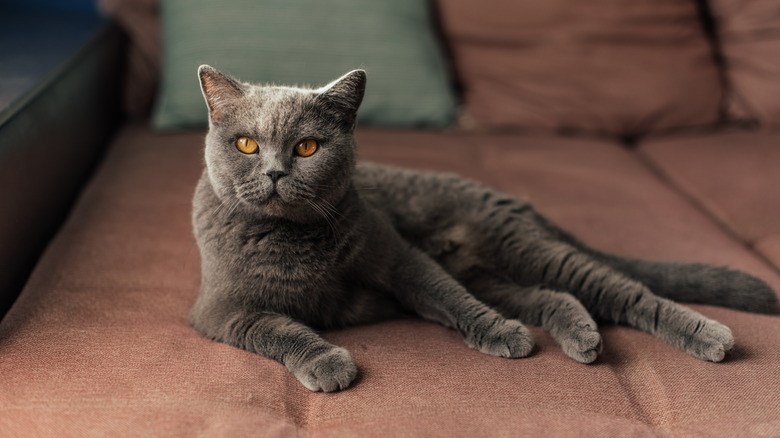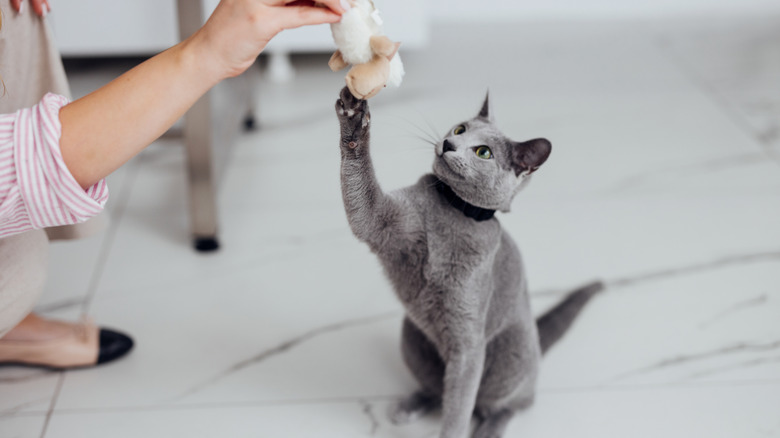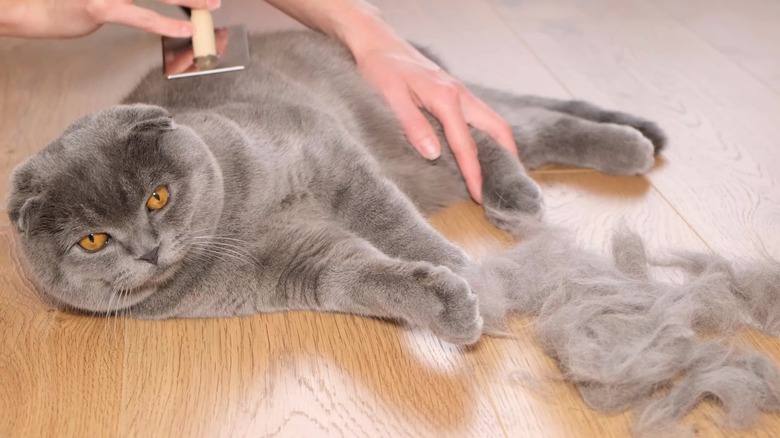How To Spot The Difference Between A British Shorthair And A Russian Blue
British shorthairs and Russian blues are both adorable cat breeds, but they actually aren't all that similar. Though they vary in personality and needs, perhaps the easiest way to spot the difference between them is to examine their physical appearances. The Russian blue cat breed is medium-sized with a short, silvery-gray coat. Russian blue cats can often be good for people with allergies, as their shiny, short hair isn't as prone to shedding as many other cat breeds. While the British shorthair cat breed often sports similar characteristics to the Russian blue, such as a plush, silver coat, they also come in many different shades and patterns.
One of the main physical differences between the two breeds is their size, as British shorthairs range from medium large, with males weighing up to 17 pounds. In contrast, Russian blues typically weigh between 7 and 15 pounds. Other physical contrasts include their eye color, with Russian blues often possessing bright, green eyes and British shorthairs having orange, green, or blue eyes. When it comes to body type, British shorthairs are what some might consider a chunkier breed, with rounded, compact, and muscular bodies. On the other hand, Russian blues tend to be leaner, with long bodies and legs. Their head shapes also showcase a divergence, with British shorthairs famous for their round faces and Russian blues having a wedge-shaped head.
British shorthairs and Russian blues have some key personality differences
British shorthair and Russian blue cats both have great personalities, so if you are deciding between the two breeds, it's all about finding the best fit for you and your lifestyle. While they have some similar traits, they also differ in their demeanor and attachment styles.
British shorthairs tend to have an easy-going nature. These chunky little guys like to show affection, but you don't need to worry about them being too clingy. They enjoy a good play session, but also like to lounge around with their loved ones. As extremely loyal cats, British shorthairs create deep bonds with their owners and family. Along with humans, the British shorthair's laidback personality often allows them to bond with other pets as well.
Like the British shorthair, Russian blues are fiercely loyal felines; however, they tend to only attach themselves to one specific person. Yet, this doesn't mean they won't show affection to anyone else. While Russian blues love to hang out with their human, they also enjoy some independence every once in a while. They are a playful breed when they feel comfortable, but they tend to be more reserved around strangers. Similar to the British shorthair, Russian blues tend to get along with dogs and other cats.
Russian blues and British shorthairs vary in terms of needs and health tendencies
These two cat breeds have different environmental requirements. Because British shorthairs like to go with the flow, they usually adapt well to change and don't really care where they are as long as they have their family with them. On the other hand, Russian blues aren't as open to change and often prefer familiar and serene schedules and living quarters. However, both cats enjoy their alone time, so you don't need to worry about leaving them by themselves when you go off to work. When it comes to grooming, neither requires much thanks to their short coats. Occasional brushing and bathing, along with frequent nail trims, is all they typically need.
When thinking about adopting one of these breeds, make sure you are prepared to give them the care they need for their whole lives. Both tend to be healthy, with a life expectancy of up to 20 years. However, they do have some health conditions to look out for. British shorthairs can experience urinary tract and kidney issues, as well as a heart condition called hypertrophic cardiomyopathy. When it comes to Russian blues, they are prone to polycystic kidney disease, as well as obesity due to their love of food.


